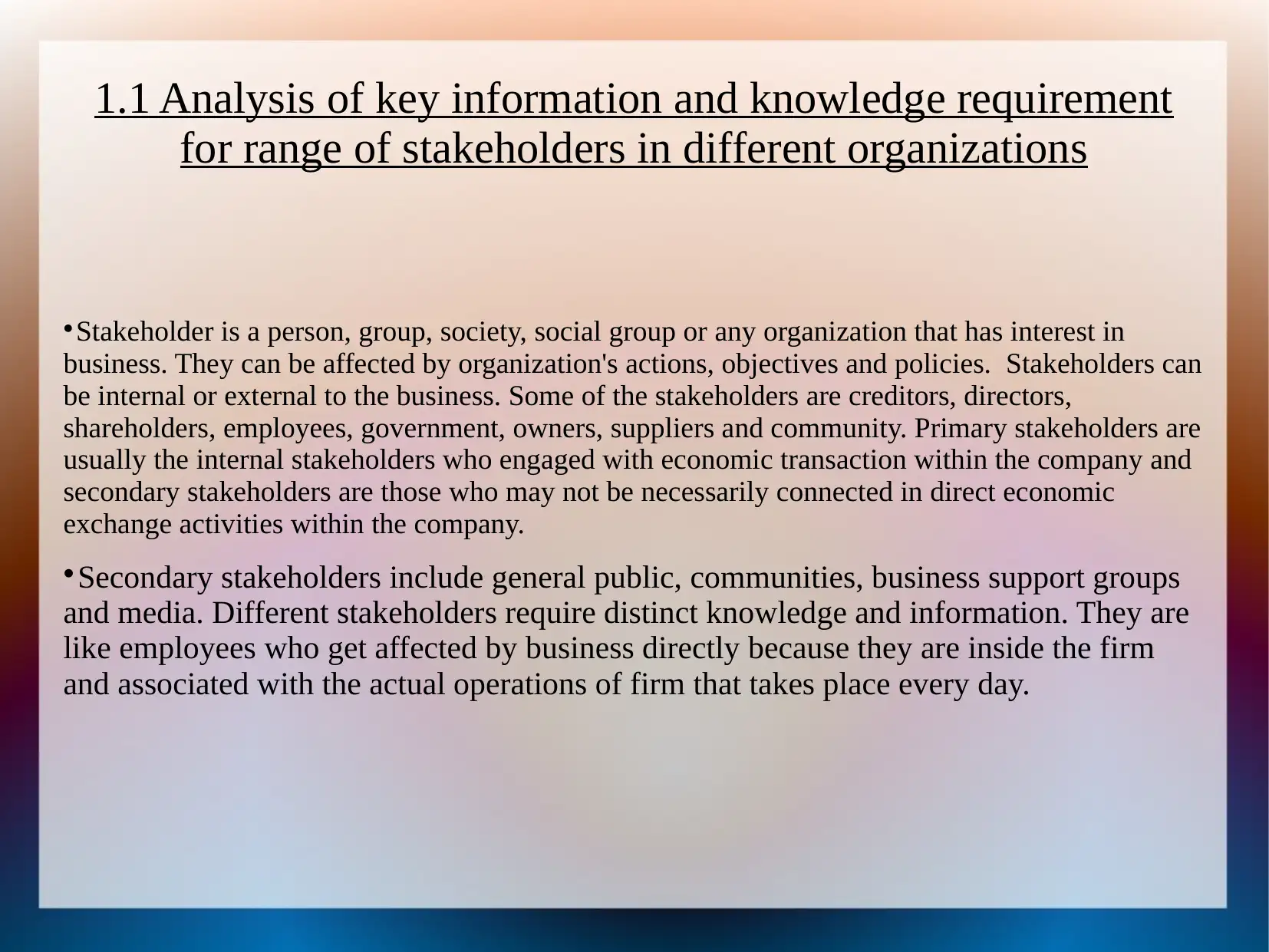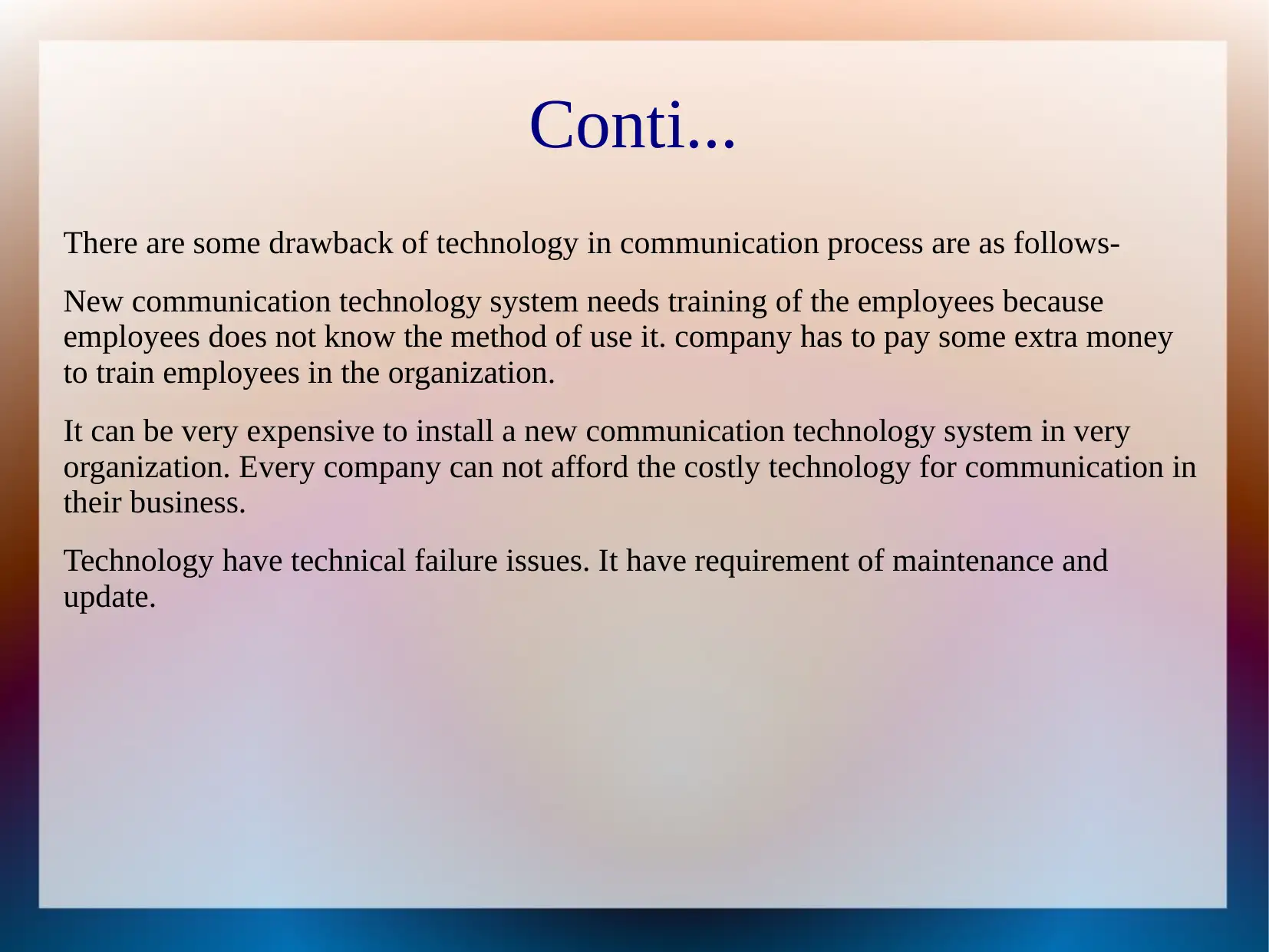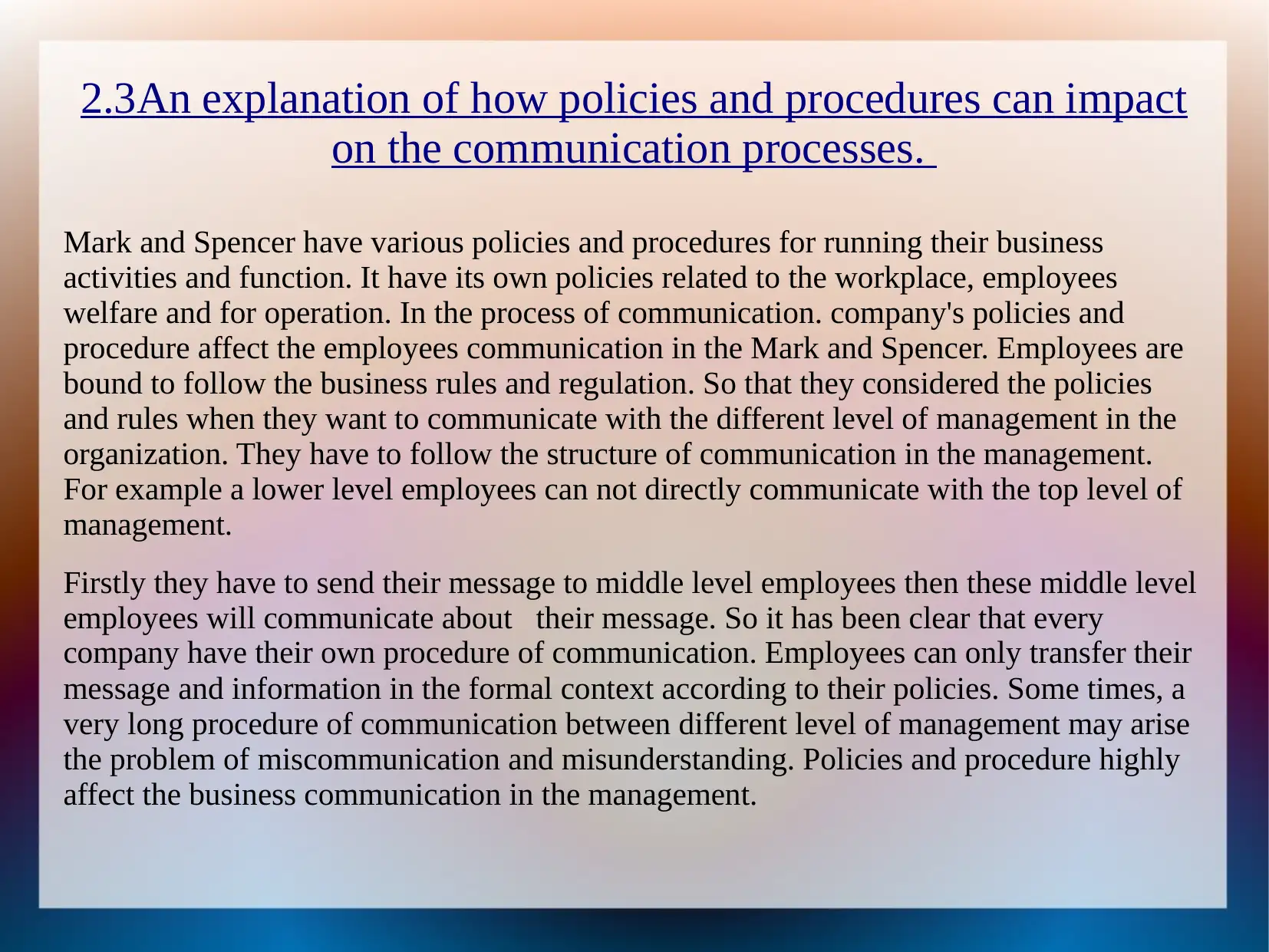Managing Communication: Stakeholders, Barriers, and Influences
VerifiedAdded on 2023/04/20
|9
|1502
|287
Presentation
AI Summary
This presentation provides an analysis of communication within organizations, focusing on stakeholders, communication systems, potential barriers, and the influence of values and cultural factors. It explores how different stakeholders require distinct knowledge and information and examines various communication systems, including formal methods like meetings and conferences, as well as channels such as company websites and social media. The presentation identifies potential barriers to effective workplace communication, such as language barriers, physical barriers, emotional barriers, and perceptual barriers. It evaluates how communication is influenced by cultural differences and social classes, highlighting the impact of values, beliefs, and lifestyles on communication styles. Furthermore, it explains how technology can both benefit and hinder the communication process, discussing the advantages of social media, email, and company web profiles, as well as the drawbacks of training requirements, costs, and technical failures. Finally, it analyzes how organizational policies and procedures can impact communication processes, emphasizing the importance of following business rules and regulations and the potential for miscommunication due to long communication procedures.

1.1 Analysis of key information and knowledge requirement
for range of stakeholders in different organizations
Stakeholder is a person, group, society, social group or any organization that has interest in
business. They can be affected by organization's actions, objectives and policies. Stakeholders can
be internal or external to the business. Some of the stakeholders are creditors, directors,
shareholders, employees, government, owners, suppliers and community. Primary stakeholders are
usually the internal stakeholders who engaged with economic transaction within the company and
secondary stakeholders are those who may not be necessarily connected in direct economic
exchange activities within the company.
Secondary stakeholders include general public, communities, business support groups
and media. Different stakeholders require distinct knowledge and information. They are
like employees who get affected by business directly because they are inside the firm
and associated with the actual operations of firm that takes place every day.
for range of stakeholders in different organizations
Stakeholder is a person, group, society, social group or any organization that has interest in
business. They can be affected by organization's actions, objectives and policies. Stakeholders can
be internal or external to the business. Some of the stakeholders are creditors, directors,
shareholders, employees, government, owners, suppliers and community. Primary stakeholders are
usually the internal stakeholders who engaged with economic transaction within the company and
secondary stakeholders are those who may not be necessarily connected in direct economic
exchange activities within the company.
Secondary stakeholders include general public, communities, business support groups
and media. Different stakeholders require distinct knowledge and information. They are
like employees who get affected by business directly because they are inside the firm
and associated with the actual operations of firm that takes place every day.
Paraphrase This Document
Need a fresh take? Get an instant paraphrase of this document with our AI Paraphraser

1.2 Explanation of systems used for communicating
information and knowledge
Communication system is a path and way through which stakeholders can communicate
with the organization. Through communication system, they can get the knowledge and
information related to company's updated policies, financial condition as well as
profitability and so on. Different stakeholders can communicate with different systems
of communication like customers and suppliers as they can interconnect with the firm by
marketing and promotional activities. Through marketing of products and services,
customers can get information and they can interact with the firm by online or any other
medium of promotional activities.
Employees can get connected by their management through meetings, conferences,
emails, newsletters, etc. These are formal methods of communication. Through
meetings, employees can send and get message by many people at a single time. This is
an effective system for internal stakeholders. Government can also communicate with
company by regular interval meetings. Secondary stakeholders require less sensitive
and normative information. They can use the channel such as company's websites or
emails. Social media is another effective system of communication. Under this,
stakeholders can directly communicate with company's representatives.
information and knowledge
Communication system is a path and way through which stakeholders can communicate
with the organization. Through communication system, they can get the knowledge and
information related to company's updated policies, financial condition as well as
profitability and so on. Different stakeholders can communicate with different systems
of communication like customers and suppliers as they can interconnect with the firm by
marketing and promotional activities. Through marketing of products and services,
customers can get information and they can interact with the firm by online or any other
medium of promotional activities.
Employees can get connected by their management through meetings, conferences,
emails, newsletters, etc. These are formal methods of communication. Through
meetings, employees can send and get message by many people at a single time. This is
an effective system for internal stakeholders. Government can also communicate with
company by regular interval meetings. Secondary stakeholders require less sensitive
and normative information. They can use the channel such as company's websites or
emails. Social media is another effective system of communication. Under this,
stakeholders can directly communicate with company's representatives.

1.3 Analysis of potential barriers to effective workplace
communication
At Mark and Spencer, communication is important for exchanging important message
and information about company's activities and functions. If this information cannot be
transferred in a proper manner to the right person at the workplace, it may create conflicts
and issues related to operations of business. There are some potential barriers which
affect the communication in firm. The most common barrier is language barrier as in
M&S, in this many employees are working that are from different states or countries.
They have their own language according to their nations and cultures.
In that case, they cannot communicate in their local language. Another major barrier is
physical barrier. Some time employees sitting arrangement arise the miscommunication.
Employees can communicate in such conditions, either by telephone or by personal
meetings. Emotional barriers also affect the effective communication at workplace
because some employees are of shy nature or they have self-esteem issue because of
which they may not be communicate effectually. Fear and mistrust of individual are
attributes of emotional barrier. Sometimes, perceptual barriers also affect the effective
communication at Marks and Spencer. Different opinions, views and thoughts of different
people in organization affect the business functions to a high extent. Lack of interest,
attention and distraction also creates barriers in effective communication at workplace.
communication
At Mark and Spencer, communication is important for exchanging important message
and information about company's activities and functions. If this information cannot be
transferred in a proper manner to the right person at the workplace, it may create conflicts
and issues related to operations of business. There are some potential barriers which
affect the communication in firm. The most common barrier is language barrier as in
M&S, in this many employees are working that are from different states or countries.
They have their own language according to their nations and cultures.
In that case, they cannot communicate in their local language. Another major barrier is
physical barrier. Some time employees sitting arrangement arise the miscommunication.
Employees can communicate in such conditions, either by telephone or by personal
meetings. Emotional barriers also affect the effective communication at workplace
because some employees are of shy nature or they have self-esteem issue because of
which they may not be communicate effectually. Fear and mistrust of individual are
attributes of emotional barrier. Sometimes, perceptual barriers also affect the effective
communication at Marks and Spencer. Different opinions, views and thoughts of different
people in organization affect the business functions to a high extent. Lack of interest,
attention and distraction also creates barriers in effective communication at workplace.
⊘ This is a preview!⊘
Do you want full access?
Subscribe today to unlock all pages.

Trusted by 1+ million students worldwide

2.1 Evaluation of how communication is influenced by values
and cultural factors
Communication can be influence by the different values and cultures differences within
people in Marks and Spencer. Cultures reflect in the personality of an individuals and his
communication ways. Culture is the values, attitudes and ways of doing things that a
person either brings with them from the particular place or they carried up by their child.
These values and attitudes can have an impact on communication. Social class also
affect the communication between the individual in the organisation. When persons are
interact with each other in the business for fulfilling business activities and function. For
this they needs to share some views and opinion and also have to communicate with
each other. At this time they represent their values and cultures to which they belong
Cultures includes their language, beliefs, thoughts and regions so that every individuals
always shows these attributes when they communicate with each other. Also different
life experiences and life styles affect the individual ways of talking with other. It has
been clear that every individual have some values and cultural difference which shows
by their personality and ways of communication. These cultural and values factors affect
individuals thoughts, opinions and view related to workplace and company's activities..
and cultural factors
Communication can be influence by the different values and cultures differences within
people in Marks and Spencer. Cultures reflect in the personality of an individuals and his
communication ways. Culture is the values, attitudes and ways of doing things that a
person either brings with them from the particular place or they carried up by their child.
These values and attitudes can have an impact on communication. Social class also
affect the communication between the individual in the organisation. When persons are
interact with each other in the business for fulfilling business activities and function. For
this they needs to share some views and opinion and also have to communicate with
each other. At this time they represent their values and cultures to which they belong
Cultures includes their language, beliefs, thoughts and regions so that every individuals
always shows these attributes when they communicate with each other. Also different
life experiences and life styles affect the individual ways of talking with other. It has
been clear that every individual have some values and cultural difference which shows
by their personality and ways of communication. These cultural and values factors affect
individuals thoughts, opinions and view related to workplace and company's activities..
Paraphrase This Document
Need a fresh take? Get an instant paraphrase of this document with our AI Paraphraser

2.2An explanation of how technology can be used to benefit as
well as hinder the communication process
Technology is very helpful to business communication. Through this it can be easily
transfers information by one department or level of management to another department.
There are various benefits of technology in communication are as follows-
Marks and Spencer can easily update their profile at the Social media and update
customers review related to product and services by internet and computers.
Company can get information related to the market share and securities through
technology. Also it can deal with their client and customers.
Internal and external stakeholders can easily get company's related information and
communicate with each others by email, social networking site, company web profile.
With the help of technology, Marks and Spencer can able to save their finance because
task can be completed with a touch of a button of technology. There has no need to old
resources and ways of communication such as post letters and paper application.
well as hinder the communication process
Technology is very helpful to business communication. Through this it can be easily
transfers information by one department or level of management to another department.
There are various benefits of technology in communication are as follows-
Marks and Spencer can easily update their profile at the Social media and update
customers review related to product and services by internet and computers.
Company can get information related to the market share and securities through
technology. Also it can deal with their client and customers.
Internal and external stakeholders can easily get company's related information and
communicate with each others by email, social networking site, company web profile.
With the help of technology, Marks and Spencer can able to save their finance because
task can be completed with a touch of a button of technology. There has no need to old
resources and ways of communication such as post letters and paper application.

Conti...
There are some drawback of technology in communication process are as follows-
New communication technology system needs training of the employees because
employees does not know the method of use it. company has to pay some extra money
to train employees in the organization.
It can be very expensive to install a new communication technology system in very
organization. Every company can not afford the costly technology for communication in
their business.
Technology have technical failure issues. It have requirement of maintenance and
update.
There are some drawback of technology in communication process are as follows-
New communication technology system needs training of the employees because
employees does not know the method of use it. company has to pay some extra money
to train employees in the organization.
It can be very expensive to install a new communication technology system in very
organization. Every company can not afford the costly technology for communication in
their business.
Technology have technical failure issues. It have requirement of maintenance and
update.
⊘ This is a preview!⊘
Do you want full access?
Subscribe today to unlock all pages.

Trusted by 1+ million students worldwide

2.3An explanation of how policies and procedures can impact
on the communication processes.
Mark and Spencer have various policies and procedures for running their business
activities and function. It have its own policies related to the workplace, employees
welfare and for operation. In the process of communication. company's policies and
procedure affect the employees communication in the Mark and Spencer. Employees are
bound to follow the business rules and regulation. So that they considered the policies
and rules when they want to communicate with the different level of management in the
organization. They have to follow the structure of communication in the management.
For example a lower level employees can not directly communicate with the top level of
management.
Firstly they have to send their message to middle level employees then these middle level
employees will communicate about their message. So it has been clear that every
company have their own procedure of communication. Employees can only transfer their
message and information in the formal context according to their policies. Some times, a
very long procedure of communication between different level of management may arise
the problem of miscommunication and misunderstanding. Policies and procedure highly
affect the business communication in the management.
on the communication processes.
Mark and Spencer have various policies and procedures for running their business
activities and function. It have its own policies related to the workplace, employees
welfare and for operation. In the process of communication. company's policies and
procedure affect the employees communication in the Mark and Spencer. Employees are
bound to follow the business rules and regulation. So that they considered the policies
and rules when they want to communicate with the different level of management in the
organization. They have to follow the structure of communication in the management.
For example a lower level employees can not directly communicate with the top level of
management.
Firstly they have to send their message to middle level employees then these middle level
employees will communicate about their message. So it has been clear that every
company have their own procedure of communication. Employees can only transfer their
message and information in the formal context according to their policies. Some times, a
very long procedure of communication between different level of management may arise
the problem of miscommunication and misunderstanding. Policies and procedure highly
affect the business communication in the management.
Paraphrase This Document
Need a fresh take? Get an instant paraphrase of this document with our AI Paraphraser

REFERENCES
Klenk, N. L. and et.al.,2015. Stakeholders in climate science: Beyond lip
service?.Science.350(6262). pp.743-744.
Kreuter, M. W. and McClure, S. M., 2004. The role of culture in health
communication.Annu. Rev. Public Health.25. pp.439-455.
Rappaport, T. S. and et.al.,2015. Wideband millimeter-wave propagation measurements
and channel models for future wireless communication system design. IEEE
Transactions on Communications.63(9). pp.3029-3056.
Style, R. and Style, H., Managing Communication, Knowledge and Information.
Vidal, S. K., Red Hat, Inc., 2015.Managing software package updates using
communication pipes. U.S. Patent 9,092,295.
Zimmerman, T. S. and Shelley, A., 2016. Using Shared Journaling to Practice
Communication Skills With Couples.Techniques for the Couple Therapist: Essential
Interventions from the Experts. pp.13.
Klenk, N. L. and et.al.,2015. Stakeholders in climate science: Beyond lip
service?.Science.350(6262). pp.743-744.
Kreuter, M. W. and McClure, S. M., 2004. The role of culture in health
communication.Annu. Rev. Public Health.25. pp.439-455.
Rappaport, T. S. and et.al.,2015. Wideband millimeter-wave propagation measurements
and channel models for future wireless communication system design. IEEE
Transactions on Communications.63(9). pp.3029-3056.
Style, R. and Style, H., Managing Communication, Knowledge and Information.
Vidal, S. K., Red Hat, Inc., 2015.Managing software package updates using
communication pipes. U.S. Patent 9,092,295.
Zimmerman, T. S. and Shelley, A., 2016. Using Shared Journaling to Practice
Communication Skills With Couples.Techniques for the Couple Therapist: Essential
Interventions from the Experts. pp.13.

Thank you
⊘ This is a preview!⊘
Do you want full access?
Subscribe today to unlock all pages.

Trusted by 1+ million students worldwide
1 out of 9
Related Documents
Your All-in-One AI-Powered Toolkit for Academic Success.
+13062052269
info@desklib.com
Available 24*7 on WhatsApp / Email
![[object Object]](/_next/static/media/star-bottom.7253800d.svg)
Unlock your academic potential
Copyright © 2020–2025 A2Z Services. All Rights Reserved. Developed and managed by ZUCOL.





